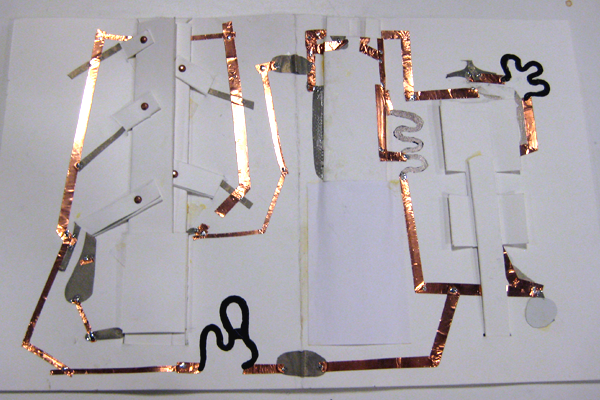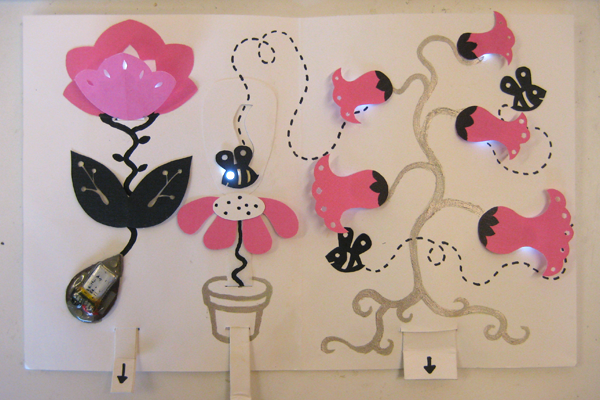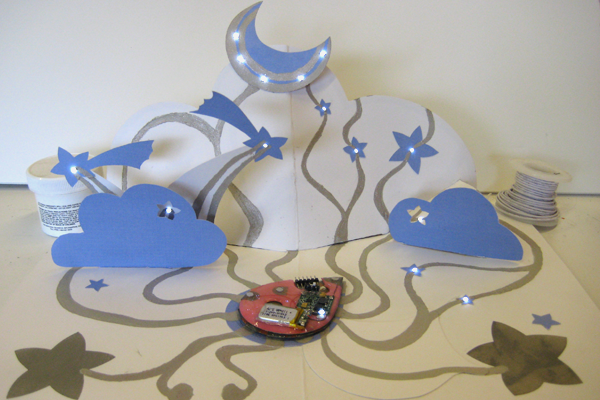|
|
home | project | blog | media |
|
week | 1-2 | 3-4 | 5-6 | 7-8 | 9-10 | 11 | week fiveMonday 6/22: the pink page I added a sliding switch to the pink page. When the use pulls the tab, a bee slides down the page as a flower rises up to meet it. Using interrupted conductive page strokes, as the bee slides down an LED on the bee blinks. So far this page is relatively simple since it only uses mechanical switches to either complete or break the connection to a battery. Using conductive paint, resistive paint, conductive fabrics, and copper tape to make circuitry is very different from the more traditional green fiberglass printed circuit board. For one, I find myself accidentally smearing the traces (and thus shorting the circuit!) as I wait for the conductive paint to dry.  Tuesday 6/23 - Thursday 6/24: visitors The past few days our lab has had three visitors-- two undergraduate students and one graduate student-- from New Mexico. They were here to learn about the Lilypad Arduino and bring it back to their school, where they hold a summer camp to introduce young women to computing. Brianna and I helped while Dr. Buechley gave them a three-day workshop on how to give a Lilypad workshop. It was a lot of fun, since none of the students had any experience programming microcontrollers so whenever a new sensor or actuator was introduced, they were super excited! The first day was a crash course in Arduino programming, which is based on Processing, which is in turn based on C. We also showed them various circuit components they could play with (LEDs, speakers, vibration motors, light sensors, temperature sensors, and numerous switches). The next day, they experimented with conductive materials (fabric and thread) and then designed and created a personal project. For example, the graduate student sewed a piano onto his T-shirt. On the last day, Dr. Buechley went through a series of common problems that may come up and how to resolve them.  In addition to helping out with this workshop, I finished up the pink pop-up page. The third component of the page is a series of flowers that rotate when a tab is pulled. As the flowers rotate, they also light up. Friday 6/25: blue page brainstorm I began working on the next pop-up page. My idea is to make a blue/night sky thesme and incorporate a resistive sensor. This particular sensor works by turning the user into a giant resistor. One end of the sensor (a piece of conductive fabric)is tied to ground and the other end (a separate piece of conductive fabric) is tied to an analog input. When a person touches both ends of the sensor simultaneously, the person acts like a large resistor connecting the input to ground. This causes the input signal to decrease. The harder the person presses on the sensors, the lower the input signal. I'm hoping to use this sensor to control a pop-up light and sound display. week sixMonday 6/28 - Tuesday 6/29: the blue page I've finally completed the blue page! This page was far more complicated than the pink page because I've had to use a magnetic arduino to control the interactions.  Unfortunately, when I was laying down the circuitry I didn't realize that the pin functionality of the paper arduino is different from the Lilypads that I've been used to. For example, one of the analog input pins had been fixed into a digital output pin. As a result, I spent a good deal of time scraping away conductive paint traces with an exacto-knife and then rerouting the circuit. This eventually led to a whole new mess of issues, though I'm happy to report that they have been mostly fixed. Right now the page works for the most part. However, sometimes the arduino loses contact with the page, which results in certain lights not blinking on. In other news, we got a new laser cutter. This machine is enormous! But extremely powerful! Dr. Buechley showed us how to use it to engrave (or "raster") a page and then cut it. I wonder if it's possible to use this cutter to cut paper PCBs. Basically, we would coat a page with conductive paint and "engrave" away the portions that are not part of traces. Hopefully I'll get to try this out soon. Wednesday 6/30 - Thursday 7/1: the green page The next page I'm working on is an example of capacitive touch sensing. In this case, a person only needs to touch one place instead of connecting two ends of one sensor. The capacitive touch sensor works by reading the amount of charge on a piece of conductive material. This is done by sending alternating high and low signals to the sensing material through a very large resistor and timing how long it takes for the signal to travel from the output to the sensor. When a person touches the sensor, that person transfers charge to (or from) the conductive material, which changes the amount of time needed for the signal to reach the sensor. The theme of the page will be green, and I'm hoping to make model venus fly-traps that close when a person touches the leaves. Unfortunately, this involves using the memory wire, so the effects may not be as dramatic as in the real plants. We'll see! |